Few foods remind me quite as strongly of childhood as the fish finger. Though I claimed not to like fish for an embarrassingly long time, these orange sticks, which tasted largely of salt and margarine, were far enough removed from anything with fins to meet my approval – which was fortunate given that, like most British schoolchildren at the time, we had them almost every Friday for a decade or so. Like the Jammy Dodger or orange squash, the fish finger, which celebrated its diamond jubilee last year, has become an infant institution. Generations of us have grown up at the Captain’s table, and such is the strength of its nostalgic appeal that the fish finger sandwich is now a fixture on menus aimed at drunk adults, too.
The Guardian’s product and service reviews are independent and are in no way influenced by any advertiser or commercial initiative. We will earn a commission from the retailer if you buy something through an affiliate link. Learn more.
The frozen variety has certainly improved since the 80s, when they were grey and fluffy, and contained, if memory serves, no actual flakes of fish – or perhaps I just pay more for them than my school kitchen. But, handy as they are for last-minute meals, the homemade sort is a real treat. A robust piece of perfectly seasoned fillet, coated in a hot, crisp, savoury crumb is ample proof that fish fingers are not a taste you ever have to grow out of.
The fish
Though originally developed as a way to shift surplus herring, fish fingers have long been associated with meaty white fish such as cod, haddock or, in recent times, more populous alternatives such as pollack or whiting. Our growing obsession with salmon, which last year overtook tuna for the first time as Britain’s favourite fish, does not seem to have dimmed our ardour for the classic white fish finger. Birds Eye has given up trying to flog a salmon alternative, and after trying the version in Jamie Oliver’s new book, Super Food Family Classics, I think they made the right decision. My testers agree: biting into a salmon fish finger “feels weird”, they say, and they don’t like it: “too strong”, apparently. Fish finger fans are clearly a conservative bunch.
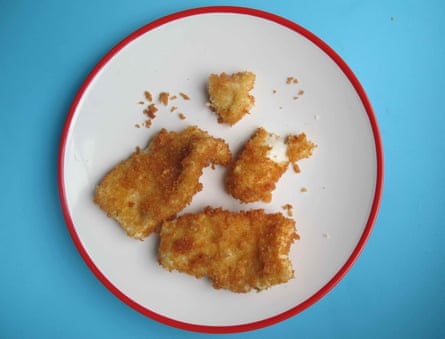
Rick Stein uses lemon sole for his goujons (it’s unclear to me exactly where the line lies between these and homemade fish fingers, if indeed there is one, especially as he specifies they should be cut “to about the size of your finger”) but this delicate flat fish is even easier to overcook. Something more robustly sized is a better bet if you’re not deep-frying like Stein (of which more later).
All the other recipes I try use white fish of some description, with Gordon Ramsay suggesting pollack and John Torode’s book My Kind of Food recommending cod or haddock. Whatever looks good on the day is probably the best bet; even if you’re buying it frozen, have a rummage around until you find a bag with a few good thick meaty fillets in there instead of a load of small thin ones.
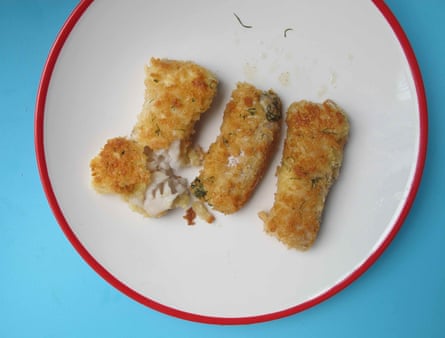
Ramsay recommends salting the fish and leaving it for 20-30 minutes “to firm up”. While I don’t find any of the recipes I try especially floppy, I do think this improves the flavour no end, effectively seasoning it from the inside out. Torode directs the reader to turn the fillet “so the sloping edges … are facing you head on” in order to “cut against the grain – if you don’t, the fish will fall apart as it cooks”. Wise advice indeed.
The coating
If you want authentic, then please, allow me to point you in the direction of the Hairy Biker’s recipe, which uses a tub of golden breadcrumbs I recognise from afternoons spent cleaning out my mum’s cupboards for pocket money. Made from seasoned flour garishly coloured with turmeric and paprika extract, they provide that authentic orange glow, and, like Torode’s fine breadcrumbs, form a solid casing around the fish that other, rougher-textured varieties such as Oliver, Stein and Vanessa Kimbell’s fresh crumbs cannot replicate. This, it would seem to me, is an essential quality of the fish finger, as opposed to mere breaded fish; it should have a breadcrumb shell, rather than a haphazard coating, which demands a fine crumb.

Torode uses polenta as well as breadcrumbs, which gives his coating a satisfying graininess, but nothing can compete with Ramsay’s panko breadcrumbs when it comes to crunch. This Japanese variety is also made from wheat bread, but panko are, as he explains, “flakier than other crumbs, and give fried food a lighter coating that stays crispy for longer”.
My problem is that, delicious as this is, mere crispness is not enough, and panko will never come together into the solid shell I’m after. My solution is to grind half of them more finely, and then use these in combination with the larger flakes. If you prefer, you can replace the ground panko with another kind of fine, dry (cheaper!) breadcrumb.
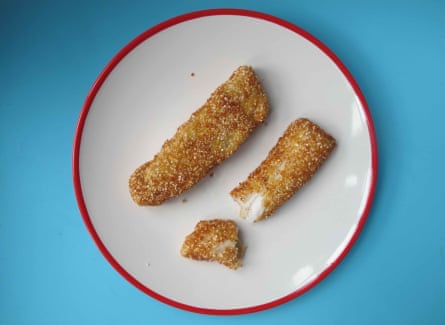
Seasoning
My instinct is to keep the crumb pretty plain out of loyalty to the original version; I’m pretty sure Captain Birdseye would have a few things to say about Oliver’s smoked paprika, or Ramsay’s dill. That said, he’s a fictional sea captain, not a chef, and although I’m not a big fan of the cheese-and-fish combination some recipes employ (cheddar for Oliver; parmesan for Stein), most of the other seasonings work very nicely. Kimball’s garlic, lemon zest and tarragon sourdough crumbs, from her book Food for Thought, are good enough to eat on their own, like Spanish migas, and Oliver’s paprika and Stein’s cayenne add a subtle touch of spice that feels oddly thrilling in such a homely context. Go mad with herbs and spices if you must, but don’t come crying to me if your fish fingers don’t taste right.
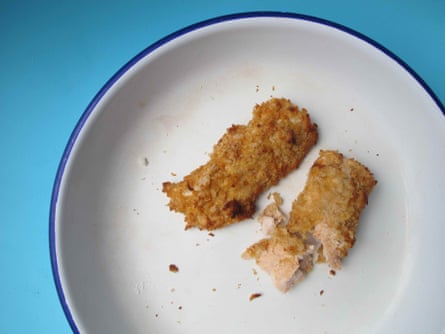
Cooking
Those of my youth were invariably baked or grilled, but now I’ve tried them fried, I don’t think any amount of nostalgia could tempt me back to the oven. Not only does frying the fish fingers give them an unbeatably crisp, delicious coating, but it’s faster, which means the fish inside doesn’t dry out during cooking. As we’re going for fish fingers, rather than Stein’s fancy goujons, there’s no need to incur Mary Berry’s wrath with deep-frying, or even for Torode’s shallow-fried alternative, when Ramsay’s pan-fried recipe, in a pan barely coated with oil, works so well.
Like Stein, he suggests sunflower oil, which I like for its neutral flavour. Kimbell goes for rapeseed and Oliver olive oil, both of which work well if you prefer the taste, but I’ve fallen for Ramsay’s idea of finishing the fish fingers with a modest knob of butter to replicate and improve on that faint margarine flavour I remember from childhood. If you’re concerned about your fat intake, leave it off your peas instead; I promise you won’t regret it. (And yes, fish fingers must always be eaten with peas, if not between two squishy slices of white bread. It’s the law.)
Makes about 12 fingers
500g chunky fillets of firm white fish, eg pollack, whiting, cod or haddock
Fine salt
100g panko breadcrumbs (or 50g panko, 50g fine dry breadcrumbs)
50g plain flour
2 eggs, beaten with a little milk
Neutral oil, to fry
Small knob of butter
Lightly salt the fish, cover and leave for 20 minutes, then pat dry with kitchen paper. Cut against the grain of the flakes into chunky fingers of your desired size.
Finely grind half the panko breadcrumbs in a food processor or using a stick blender or rolling pin, if using the full 100g. Put these, or the fine dry breadcrumbs, if using these instead, in a wide shallow bowl with the remaining coarse panko, mixing well. Put the beaten eggs in a second wide shallow bowl, and the flour in a third.
Coat the fingers first in flour, then in egg, shaking off any excess, then roll in crumbs until completely coated.
Pour enough oil into a wide frying pan to just cover the base, and put on a medium to high heat until shimmering. Add the fish fingers and cook for about two to three minutes until golden, then turn and do the same on the other side. Just before they’re ready, add the butter and swirl the pan to melt.
Drain the fish fingers on kitchen paper and serve immediately.
Fish fingers: the ultimate culinary nostalgic trip, or a waste of a good piece of fish? And, fellow fish finger lovers, am I right in that they’re best served with mash and peas, or do you prefer them in a sandwich, or (heresy!) contaminated with chips and beans?
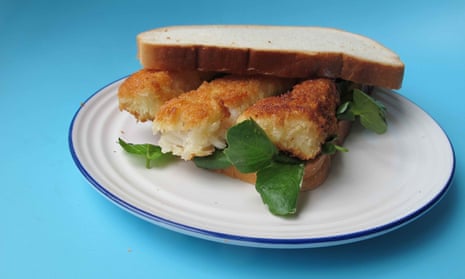
Comments (…)
Sign in or create your Guardian account to join the discussion